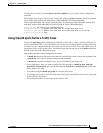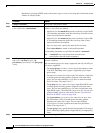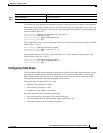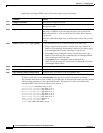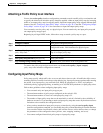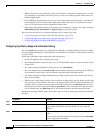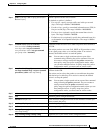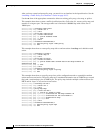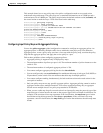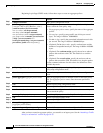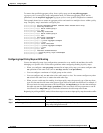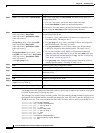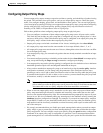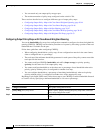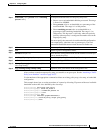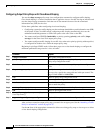
30-39
Cisco ME 3400 Ethernet Access Switch Software Configuration Guide
78-17058-01
Chapter 30 Configuring QoS
Configuring QoS
This example shows how to use policy-map class police configuration mode to set exceed action
mark-down using table-maps. The policy map sets a committed information rate of 23000 bps and a
conform burst-size of 10000 bytes. The policy map includes the default conform action (transmit) and
the exceed action to mark the Layer 2 CoS value based on the table map.
Switch(config)# policy-map in-policy
Switch(config-pmap)# class in-class-1
Switch(config-pmap-c)# police cir 23000 bc 10000
Switch(config-pmap-c-police)# exceed-action set-cos-transmit cos table
police-cos-markdn-tablemap
Switch(config-pmap-c-police)# exit
Switch(config-pmap-c)# exit
Switch(config-pmap)# exit
Switch(config)# interface fastethernet0/1
Switch(config-if)# service-policy input in-policy
Switch(config-if)# exit
Configuring Input Policy Maps with Aggregate Policing
You use the policer aggregate global configuration command to configure an aggregate policer. An
aggregate policer is shared by multiple traffic classes within the same policy map. You define the
aggregate policer, create a policy map, associate a class map with the policy map, associate the policy
map with the aggregate policer, and apply the service policy to a port.
Follow these guidelines when configuring aggregate policers:
• Aggregate policing is supported only on input policy maps.
• The maximum number of policers per port is 48. The maximum number of policer instances on the
switch is 229.
• The maximum number of configured aggregate policers is 256.
• You cannot configure aggregate policing for the class class-default.
• You can configure only one exceed-action police markdown table map of each type (CoS, DSCP, or
IP precedence) on the switch. You can reference that table map in multiple policers.
• You cannot configure marking simultaneously for both conform-action and exceed-action for the
same policer instance.
• Only one policy map can use any specific aggregate policer. Aggregate policing cannot be used to
aggregate streams across multiple interfaces. You can use aggregate policing only to aggregate
streams across multiple classes in a policy map attached to an interface.
• When you use a table map for police exceed-action in an input policy map, the protocol type of the
map from type of action must be the same as the protocol type of the associated classification. For
example, if the associated class map represents an IP classification, the map from type of action
that references the table map must be either dscp or precedence. If the associated class map
represents a non-IP classification, the map from type of action that references the table map must
be cos.



